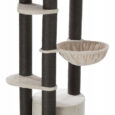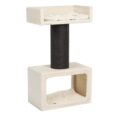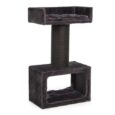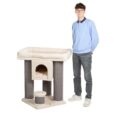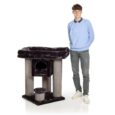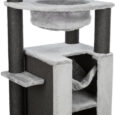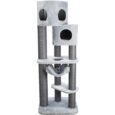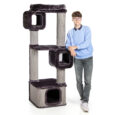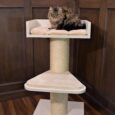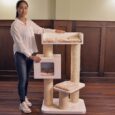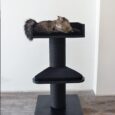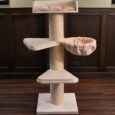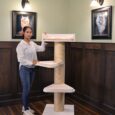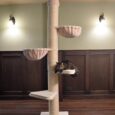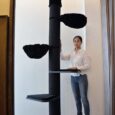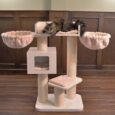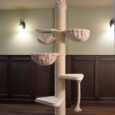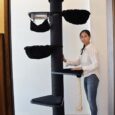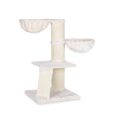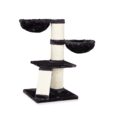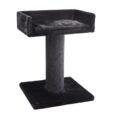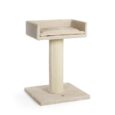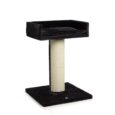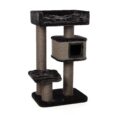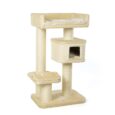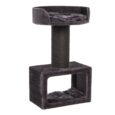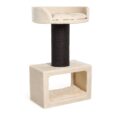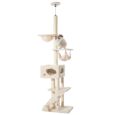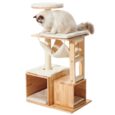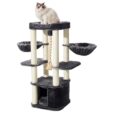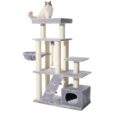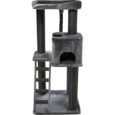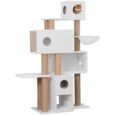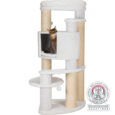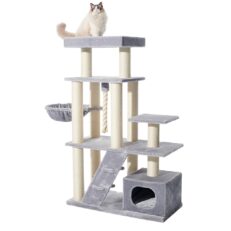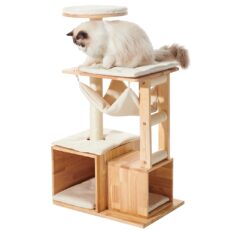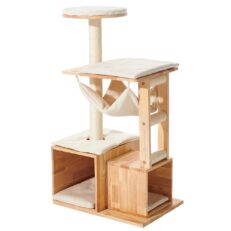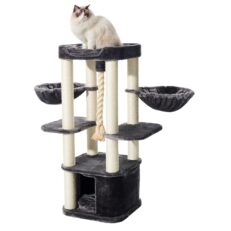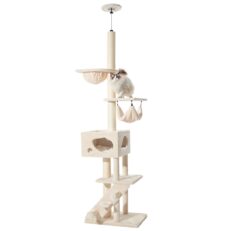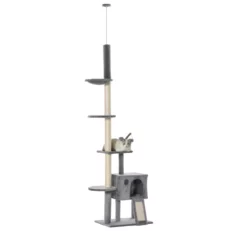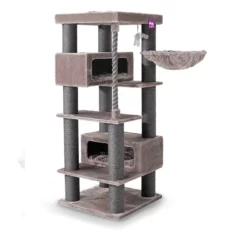
Cat trees play a crucial role in supporting the health and stimulation of felines. They offer cats an opportunity to engage in natural behaviors such as climbing, scratching, and surveying their environment from a high vantage point. For indoor cats especially, cat trees provide an essential outlet for physical exercise, helping to prevent obesity and related health issues. Additionally, they satisfy the scratching instinct, helping to keep claws healthy and to divert cats from scratching less appropriate household items.
The specific needs of older cats must be carefully considered when choosing a cat tree. As cats age, they may face challenges such as reduced mobility, joint pain due to arthritis, diminished muscle tone, and a decrease in energy. Therefore, a cat tree for senior cats should accommodate these changes to ensure they can still enjoy the benefits without risking injury or discomfort.
Factors to consider for cat trees suitable for senior cats include:
Ease of Climbing: Gentle, low-gradient ramps or easy steps can help older cats with diminished jumping ability access the tree. Platforms should be positioned close together to make climbing easier.
Comfort: Soft, orthopedic bedding can provide additional support for aging joints and make resting more comfortable. Also, the perches and cubbies should be large enough to accommodate the cat comfortably without needing to jump or contort to fit.
Stability: A solid, heavy base is crucial to ensure that the cat tree doesn’t wobble or tip over as the older cat climbs or leans against it. This stability can help an older cat feel secure when using the tree.
Height and Layout: While young cats may enjoy towering heights, senior cats typically prefer lower heights due to their decreased agility. The layout should still allow them to perch at a height they feel comfortable with, as high places can help them feel safe and secure.
Accessibility: Some senior cats may have vision problems, so clear visual paths to the tree and its various components are essential. Contrasting colors can help outline edges and make navigation easier.
Scratching Surfaces: Providing various scratching surfaces at different angles can cater to the cat’s preferences while considering reduced flexibility. Lower areas where they can scratch without stretching too much are ideal.
Safety Features: Avoid designs with small, tight spaces where an older cat could become stuck or cramped. Edges should be rounded to prevent injury, and any hanging toys should be securely attached and checked regularly for potential hazards.
Incorporating these features will ensure that the cat tree is not only a source of fun and exercise for an older cat but also a safe and supportive environment for their well-being.
As cats enter their senior years, typically around the age of 11 to 14, they experience various age-related changes that can affect their mobility and activity levels. Understanding these changes is crucial to ensure that they continue to have a good quality of life. Here’s a breakdown of the considerations you mentioned:
A. Age-related Changes in Mobility and Activity Levels
Joint Health: Arthritis is common in older cats, though they may not show obvious signs of joint pain. You might notice your cat hesitating before jumping, or not climbing to their favorite perches anymore.
Muscle Mass: Senior cats may lose muscle mass, making them weaker and less able to engage in the activities they once enjoyed.
Balance and Coordination: Age can affect a cat’s balance and coordination, increasing the risk of falls and injuries.
Energy Levels: Older cats may have less energy and sleep more than younger cats.
Sensory Changes: Deterioration in vision or hearing can also impact a cat’s ability to navigate their environment, potentially making them more cautious about movement.
B. Importance of Low-Impact Exercise for Senior Cats
Maintaining Muscle Tone: Gentle exercise helps maintain muscle tone and can help manage weight, which is crucial as obesity can exacerbate mobility issues.
Joint Flexibility: Regular movement can help keep joints more flexible and may slow the progression of arthritis.
Stimulating Circulation: Exercise improves blood circulation, which is vital for overall health and can help with healing and immune function.
Enhancing Well-being: Exercise can also help reduce the risk of depression and anxiety in cats, which can be a concern in older pets who are less active.
C. The Role of Comfort and Easy Accessibility in Preventing Injuries
Comfortable Bedding: Orthopedic cat beds can provide support for joints and help ease discomfort when resting.
Accessibility: Making sure food, water, litter boxes, and favorite resting places are easily accessible without the need to jump or climb can prevent injuries.
Stairs and Ramps: Providing steps or ramps to access higher places can help senior cats with decreased mobility and prevent falls.
Slip-Proof Flooring: Ensuring that floors have good traction can help prevent slips and falls; rugs and carpet runners can be beneficial.
Grooming Assistance: Older cats may struggle to groom themselves effectively, and helping them can prevent matting and skin issues.
Regular Veterinary Checkups: Keeping up with veterinary appointments can help catch and manage any mobility-related issues early.
Environmental Enrichment: Senior cats may not be able to play as vigorously as they once did, but they still benefit from environmental enrichment to keep them mentally stimulated.
Pain Management: If a cat is in pain, a vet might prescribe medications or supplements to help manage this, which can improve their ability to move and engage in low-impact exercise.
Understanding and adapting to the changing needs of senior cats are crucial aspects of caring for them in their later years. Gentle and appropriate care can help maintain their health and comfort as they age.
Cat trees for older cats are specially designed with their comfort and mobility needs in mind. Here’s how the key features you listed benefit senior felines:
A. Step-like platforms for easy climbing: As cats age, they often develop arthritis or lose some of the agility they had in their youth. Step-like platforms allow them to climb without having to jump too high, reducing the strain on their joints and making it easier for them to reach different levels of the tree.
B. Soft, orthopedic cushions for joint support: Older cats can suffer from stiff and painful joints. Orthopedic cushions help to alleviate this discomfort by providing a soft, supportive surface that contours to their body, reducing pressure points and improving circulation.
C. Stability and sturdiness to ensure safety: Senior cats may not have the balance and coordination they once had, making them more prone to falls. A stable and sturdy cat tree will minimize the risk of the tree tipping over or wobbling, which can prevent injuries resulting from falls.
D. Low-height levels for easy access: High perches can be inaccessible or intimidating for older cats. Low-height levels ensure that senior cats don’t have to climb too high to enjoy their tree, making it easier and safer for them to use.
E. Napping spots with raised edges for security: Older cats often need more sleep than their younger counterparts and tend to look for secure and comfortable spots to rest. Napping spots with raised edges can provide a sense of security and prevent them from rolling off, helping them to feel safe and protected as they sleep.
Overall, a cat tree for an older cat should be thought of as a piece of assistive furniture, accommodating their reduced mobility and increased need for comfort, and making their environment as friendly and accessible as possible in their senior years.
Customizable Options for Older Cats
Customizing cat trees and environments for older cats can significantly enhance their quality of life. Here’s how you can adapt or create the perfect space for your senior feline:
A. DIY modifications to existing cat trees
Adding steps or ramps: If you have an existing cat tree that’s too challenging for your older cat to climb, consider attaching wooden or carpeted steps or ramps to make it more accessible.
Increasing padding: Add extra layers of soft materials like fleece or memory foam to the platforms to cushion sensitive joints.
Creating lower perches: You can remove higher platforms or rearrange the configuration so that your cat can enjoy the tree without having to climb high.
Securing loose elements: Ensure all parts of the cat tree are secure to prevent wobbling, which can be unsettling for an older cat.
B. Add-on accessories like heating pads and extra cushions
Heating pads: Older cats often seek warmth. A pet-safe heating pad on a lower level of the cat tree can provide comfort, especially for those with arthritis.
Extra cushions: Placing additional cushions or soft blankets on the platforms can make the cat tree more inviting and comfortable.
Non-slip surfaces: Add non-slip mats or tapes to the platforms and ramps to prevent slipping and to boost your cat’s confidence while climbing.
C. Custom-built cat trees to fit specific needs and preferences
Consult with a carpenter or pet furniture specialist: They can help design a cat tree that caters to your cat’s specific mobility limitations and preferences.
Material choices: Select materials that are sturdy yet soft for the cat’s comfort. Avoid rough textures that might irritate delicate paws.
Incorporate interactive elements: Custom-built trees can include hanging toys or scratching areas that are within easy reach to encourage gentle play without too much exertion.
Adjustable features: Design the tree with adjustable platforms or removable components so it can evolve with your cat’s changing needs.
By considering these customizable options, you can ensure that your older cat still enjoys the physical and mental stimulation that a cat tree provides while also respecting their comfort and capabilities.
Care and maintenance of cat trees are essential, particularly for older cats, as they can be more susceptible to infections and may use the cat tree more cautiously. Here are some guidelines:
A. Cleaning and Hygiene Tips
Vacuum Regularly: Use a vacuum with a hose attachment to remove fur and dirt from the cat tree. This should be done weekly or more often if your cat sheds excessively.
Spot Clean: Immediately clean any spills or accidents with pet-safe cleaners. For upholstered areas, a mild detergent and water can be used, but make sure it is thoroughly rinsed and dried to prevent residue that could irritate your cat.
Wash Fabric Components: If the cat tree has removable fabric covers or hammocks, wash them according to the manufacturer’s instructions. It’s best to use a fragrance-free, hypoallergenic detergent to avoid any adverse reactions.
Disinfect: Use a mild, cat-safe disinfectant to wipe down solid surfaces. Ensure the product is non-toxic and rinse the areas with water after disinfecting.
Replace Worn Parts: Some cat trees have replaceable parts like scratching posts or pads. Replace these as they become too worn to ensure your cat always has a suitable place to scratch.
B. Regular Inspection and Maintenance for Wear and Tear
Check Stability: Periodically test the cat tree’s stability to ensure that it hasn’t become wobbly. Tighten any loose screws or bolts.
Inspect for Damage: Look for any torn fabric, splintered wood, or exposed nails/screws that could harm your cat. These should be repaired immediately to prevent injury.
Examine Scratching Posts: If the scratching posts are wrapped in sisal rope or fabric, make sure they are not fraying to the extent that they could entangle your cat’s claws.
Look for Signs of Wear: The platforms and supports can wear out over time, especially in the favorite spots where your cat spends most of its time. Make sure these areas are still supportive and not at risk of breaking.
C. When to Replace or Upgrade Your Cat Tree
Structural Integrity: If the cat tree becomes unstable and cannot be safely repaired, it’s time to replace it. A fall from a wobbly cat tree could severely injure an older cat.
Irreparable Wear: When the surfaces for scratching are completely worn or the fabric is torn to the extent that it cannot be fixed, it’s better to replace the cat tree.
Hygienic Concerns: If there are persistent odors that can’t be removed or if mold/mildew has set in despite regular cleaning, a new cat tree is needed to maintain a healthy environment for your cat.
Changes in Your Cat’s Needs: As your cat ages, their needs might change. They might require more accessible platforms or softer resting places. If your current cat tree can’t be modified to accommodate these needs, an upgrade might be necessary.
Investing in a high-quality cat tree and performing regular maintenance will extend its lifespan, but always prioritize your older cat’s safety and comfort when deciding whether to repair or replace it.
Conclusion
Caring for an older cat involves understanding their changing needs and providing them with a comfortable environment where they can thrive. When it comes to choosing a cat tree for senior felines, several important considerations come into play.
A. Recap of the Importance of Selecting the Right Cat Tree for Older Cats
Selecting the right cat tree for older cats is crucial due to their reduced mobility and the higher risk of injury. A well-chosen cat tree can:
- Support Joint Health: Provide gentle opportunities for movement to help keep joints limber.
- Reduce Injury Risk: Minimize the height they need to jump, preventing potential falls.
- Stimulate Mentally: Keep them mentally engaged with their environment, which is essential for their overall well-being.
- Maintain Comfort: Offer easy-to-access platforms and cozy resting spots that don’t require strenuous effort to reach.
B. Encouragement to Consider the Cat’s Individual Needs and Preferences
Every cat is unique, and aging can affect each one differently. It’s important to:
- Observe Behavior: Look at your cat’s current habits to determine what features they might enjoy and use.
- Adapt to Their Lifestyle: If your cat has special medical needs, make sure the cat tree accommodates these (for instance, heated pads for arthritic cats).
- Preference Respect: Some cats prefer cozy nooks, while others might still enjoy perching high up if safely accessible.
C. Final Tips on Introducing Your Older Cat to Their New Cat Tree
When introducing a new cat tree to your older cat, patience and encouragement are key. Here are some final tips:
Familiarize Gently: Let your cat explore the new cat tree at their own pace. You can place it near their favorite area to pique their interest.
Use Incentives: Encourage exploration by using treats or catnip. Place them on different levels to motivate your cat to explore.
Comfort Over Height: Ensure the highest point is within a comfortable jump for your cat, or provide steps if they prefer not to jump at all.
Stability is Key: Make sure the cat tree is stable so it won’t wobble and scare your cat or, worse, tip over.
Demonstrate: Sometimes showing your cat how to use the cat tree by gently placing them on various levels can help them understand it’s safe and for them.
Safety Check: Regularly inspect the cat tree for wear and tear, ensuring it remains a safe place for your cat to rest and play.
In conclusion, selecting the right cat tree for an older cat and introducing them to it thoughtfully can significantly enhance their quality of life. It’s a loving way to provide your aging companion with a sense of security, comfort, and enjoyment in their golden years.




